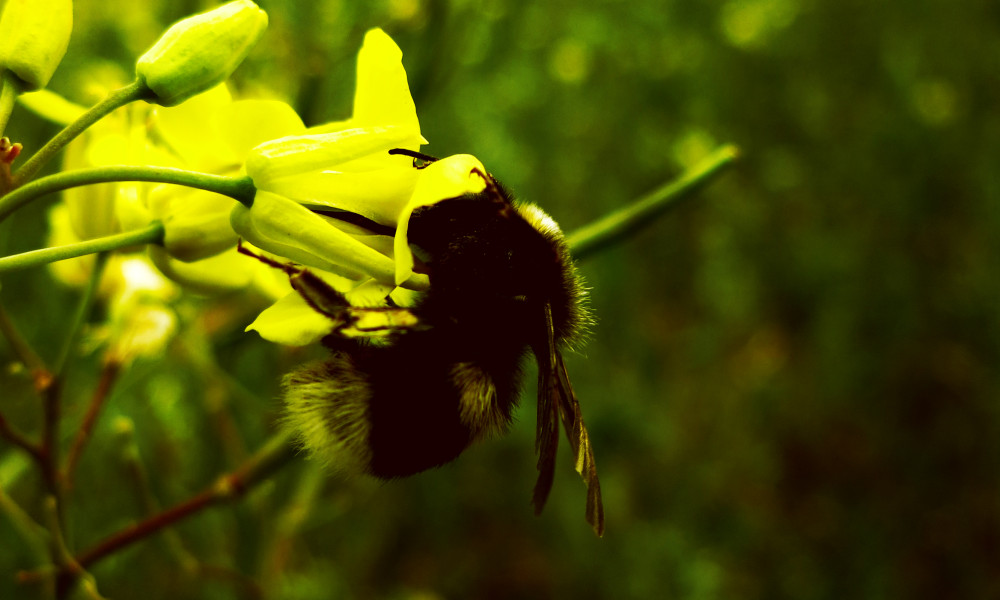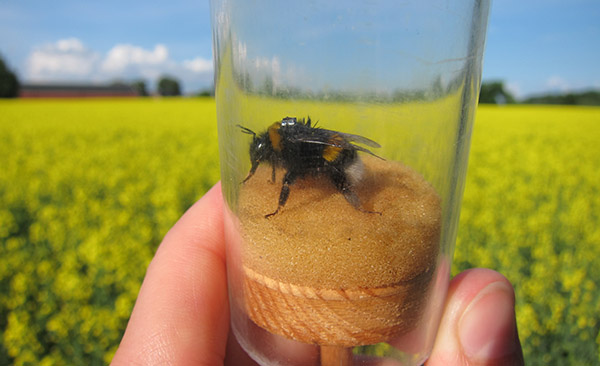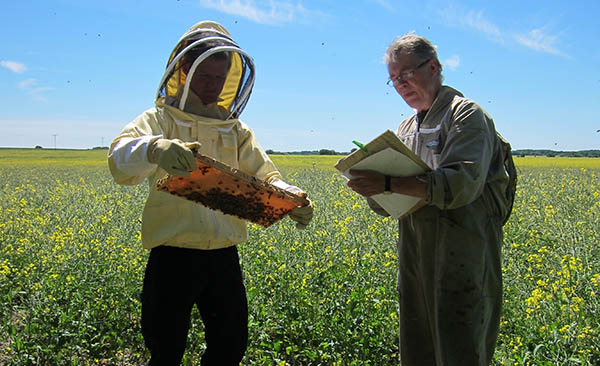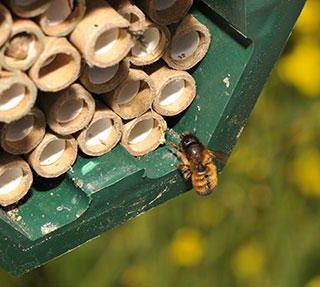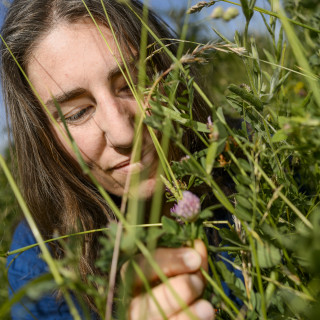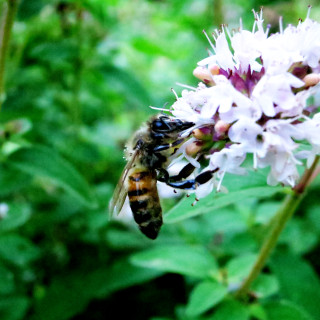All bees are needed – including wild bees
All bees are needed, both honeybees and wild bees, according to Maj Rundlöf, a researcher at Lund University. However, it also appears that all bees are at risk of decline. If all bees were to die out, we could be left without fruit and vegetables. We would be forced to live on grain and the countryside would be less colourful without flowering plants.
Bees are the primary pollinator of many of our plants. They move pollen from one plant to another so that trees, bushes, flowers and crops are fertilised and can produce seeds and fruit. They do us an invaluable ecosystem service. Now and again there are reports of mass deaths of honeybees, which are used both for honey production and for pollination. Entire colonies suddenly die or do not survive the winter. Now researchers fear that wild bee numbers are also falling.
“It may not be noticeable from harvests yet that wild bees are in decline, because we can put out honeybee colonies in many areas”, says Maj Rundlöf. “However, it is a very risky strategy to rely on only one species. We don’t know at present how widespread under-pollination is in our crops.”
Maj Rundlöf and her colleagues have observed that, over the past ninety years, red clover harvests (yield per hectare) have increased and then decreased again, while grain harvests continue to increase. One difference between these crops is that red clover is entirely dependent on insect pollination, primarily by bumblebees, whereas cereals are pollinated with the help of the wind.
“We are also discussing whether the reduced yield could be because the new varieties of red clover produce fewer seeds. Nevertheless, we do know that there have been dramatic changes in the bee population, resulting in fewer species”, says Maj Rundlöf.
It is likely that the bee population fluctuates continually, but over the past seventy years a major change has taken place. Using old studies of red clover cultivation across Sweden, the researchers have demonstrated that the bee population has gone from comprising many species that were equally represented in the 1940s to comprising fewer species with 90 per cent domination of 1–2 species in the 2000s.
“Wild bees are twice as efficient pollinators as honeybees.”
The number of bees has probably fallen worldwide. A number of international studies have shown that the species composition of bees has changed over the past century. One of the likely reasons is changes to the agricultural landscape. A global study looking at harvests from some 40 crops has shown that wild bees play a much greater role in pollination than previously thought.
“In the study, we compared the size of the final harvest with the number of wild bees and honeybees that visited the crops. Our conclusion was that the wild bees are twice as efficient pollinators as honeybees”, says Maj Rundlöf.
Busy as a bee, we say, but that is not always an appropriate description of the honeybee. Maj Rundlöf explains that bumblebees go out and gather pollen even in cool weather, such as early in the season when fruit trees are in blossom. They can also go out in light rain or blustery weather.
“Honeybees, on the other hand, stay inside if it is bad weather, and on working days their hours are nine to five, which is shorter than the bumblebee’s day”, says Maj Rundlöf.
So, it is not a good idea to rely on the honeybee for pollination.
“We don’t know whether wild bees are sufficient to pollinate our large monocultures of cultivated crops. The advantage of the honeybee is that they live in very large colonies and we can move them to the area we want them to pollinate.”
Both honeybees and wild bees are needed to ensure that pollination can take place even in bad weather or if many honeybee colonies are affected by disease. In the view of Maj Rundlöf, we therefore need to make an active effort to preserve the diversity of wild bees, including by maintaining old pasture land and creating more varied vegetation in the landscape.
“Today, the entire agricultural process has changed”, explains Maj Rundlöf. “Farmers no longer have to think as much about crop rotation to regulate nutrient supply and keep pests and diseases in check. Instead of green fertilisation (using cultivated clover that bumblebees like), more artificial fertiliser is used, and instead of rotating or alternating crops, pesticides are employed.
In recent years, the use of a group of pesticides called neonicotinoids has been raised as a possible reason for the deaths of both honeybees and wild bees. Maj Rundlöf is now the principal investigator for a two-year study investigating the effects of neonicotinoids on honeybees, bumblebees and solitary mason bees in Swedish field conditions.
“We expect to find out whether neonicotinoids have any effect on bees when they are used in a real-life situation, just as they are used by farmers”, says Maj Rundlöf.
The results of the study could provide another piece of the jigsaw in the work to preserve biodiversity in bees so that we can continue to enjoy summer fruits and flowers.
Text: Pia Romare
Published: 2014
Facts
-
What would it cost us if bees died out?
-
What would it cost if bees died out and we had to use other methods of pollination?
Most wild plants are dependent to some extent on insect pollination, mainly by bees. The majority of crops in Sweden, such as rapeseed, fruit, berries and vegetables, and one third of global crop production are dependent to some extent on insect pollination. Certain species of plant, such as strawberries, need various different-sized pollinators to develop a well-formed fruit. Other plants need very specific pollinators.
For Sweden, the total economic value of insect pollination is estimated at between SEK 260 million and SEK 466 million in this stage of production (market value of the crops). In 2009, the total value of insect pollination of crops worldwide was estimated at EUR 153 billion. There are no estimates of the value of insect pollination of wild plants, but if loss of pollinators leads to significant changes to the flora, the potential cost is very high.
-
Causes of bee death
-
Research from the USA has shown that the reason for the death of honeybee colonies is a combination of a number of factors:
Parasites and the diseases they bring – spread by domesticated bees that are moved around
Less food and poorer quality food in the landscape
Indirect effects of pesticides
Bad weather
The latest research findings show that honeybee diseases can be spread to bumblebees. Diseases from honeybees can therefore affect wild bees as well. If different bees share diseases, there is a risk that we spread these diseases to wild bees when we move domesticated bumblebee and honeybee colonies for pollination.
-
The difference between bumlebees and honeybees
-
There are more than 20 000 species of bee in the world. In Sweden we have about 300 species of which most are solitary bees. Colony living bees belong to our, circa 40 species of bumblebee and the honeybee.
Bumblebees have ten to hundreds of workers in a colony
Honeybees have thousands of workers in a colony
Bumblebees have one queen and a colony that exists only for one year. Their goal is raising new queens who can survive the winter and start a new colony in the spring
Honeybees also have one queen but their colony exists for several years
Bumblebees fly several hundred metres. The buff-tailed bumblebee can fly several kilometres (they are more like honeybees with relatively large colonies – 100 or more workers)
Honeybees may fly up to ten kilometres
Bumblebees are much better than honeybees at gathering pollen in cool or windy weather, in light rain and during a larger part of the day. Bumblebees fly from their nests and collect nectar – partly for themselves and partly to take it to the nest in their honey stomachs and store in small wax cells. At the same time they collect in pollen baskets on their hind legs. The nectar lasts only for a few days, then they have to go out again whatever the weather.
Honeybees stay inside in bad weather – and only work nine to five!
The species that fly the furthest are better able to cope with the changing agricultural landscape – they can always find something in flower. If flowering finishes in one place and starts in another they are able to move.
Many of the solitary bees search for food within a smaller radius and are more dependent on having food close by throughout their lifetime.
-
Image of bumblebee with transponder
-
In the picture you see a bumblebee that carries a transponder – a small chip – which has a unique ID number. Using the chip and two antennas placed at the entrance of the bee hive, researchers can see when the bumblebee flyes out of the hive and when it comes back. They can thus see how long the bumblebee has been away from the hive or if it doesn’t come back at all. The chip is attached to the back of the bumblebee using superglue. A small bumblebee weighs 0.1 gram and the transponder weighs about five percent of the bumblebee weight.
Photo: Maj Rundlöf


